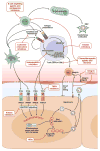Hepatitis B Reactivation Associated With Immune Suppressive and Biological Modifier Therapies: Current Concepts, Management Strategies, and Future Directions
- PMID: 28219691
- PMCID: PMC5501983
- DOI: 10.1053/j.gastro.2017.02.009
Hepatitis B Reactivation Associated With Immune Suppressive and Biological Modifier Therapies: Current Concepts, Management Strategies, and Future Directions
Abstract
Hepatitis B reactivation associated with immune-suppressive and biological therapies is emerging to be an important cause of morbidity and mortality in patients with current or prior exposure to hepatitis B virus (HBV) infection. The population at risk for HBV reactivation includes those who either currently are infected with HBV or have had past exposure to HBV. Because curative and eradicative therapy for HBV is not currently available, there is a large reservoir of individuals at risk for HBV reactivation in the general population. HBV reactivation with its potential consequences is particularly a concern when these people are exposed to either cancer chemotherapy, immunosuppressive or biologic therapies for the management of rheumatologic conditions, malignancies, inflammatory bowel disease, dermatologic conditions, or solid-organ or bone marrow transplantation. With the advent of newer and emerging forms of targeted biologic therapies, it has become important to understand the mechanisms whereby certain therapies are more prone to HBV reactivation. This review provides a comprehensive update on the current concepts, risk factors, molecular mechanisms, prevention, and management of hepatitis B reactivation. In addition, we provide recommendations for future research in this area.
Keywords: Chronic Hepatitis B; Cirrhosis; Fulminant Hepatic Failure; Guidelines; Liver Disease; Liver Failure; Mortality; Viral Hepatitis.
Copyright © 2017 AGA Institute. Published by Elsevier Inc. All rights reserved.
Conflict of interest statement
Figures



References
-
- Dienstag JL. Hepatitis B virus infection. N Engl J Med. 2008;359:1486–500. - PubMed
-
- Hoofnagle JH. Reactivation of hepatitis B. Hepatology. 2009;49:S156–65. - PubMed
-
- Doo EC, Hoofnagle JH, Rodgers GP. NIH consensus development conference: management of Hepatitis B. Introduction Hepatology. 2009;49:S1–3. - PubMed
Publication types
MeSH terms
Substances
Grants and funding
LinkOut - more resources
Full Text Sources
Other Literature Sources
Miscellaneous

